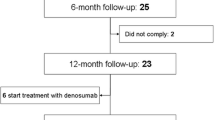Abstract
Summary
We assessed several circulating proteins as candidate biomarkers of bone status in men with chronic spinal cord injury. We report that sclerostin is significantly associated with bone mineral content and bone density at all skeletal sites tested. We found no association between bone and any other tested biomarker.
Introduction
Spinal cord injury results in severe osteoporosis. To date, no circulating biomarker of spinal cord injury (SCI)-induced osteoporosis has been identified. We recently reported that circulating sclerostin is associated with bone density in chronic SCI. In this study, we assessed several circulating proteins as candidate biomarkers of bone in men with chronic SCI.
Methods
We assessed the relationship between bone mineral content or bone density and the following circulating bone-related proteins: sclerostin, DKK-1, soluble receptor activator of nuclear factor kappa B ligand, osteoprotegerin, osteocalcin, and c-telopeptide in 39 men with chronic SCI and 10 men with no SCI.
Results
After adjusting for age, lower sclerostin levels were significantly associated with lower bone mineral content and bone density at all skeletal sites tested (p = 0.0002−0.03). No other circulating protein was associated with bone mineral content or bone mineral density (p = 0.18−0.99).
Conclusion
These findings suggest that circulating sclerostin reflects the severity of bone loss and is a candidate biomarker of osteoporosis severity in chronic SCI.


Similar content being viewed by others
References
Szollar SM, Martin EM, Sartoris DJ, Parthemore JG, Deftos LJ (1998) Bone mineral density and indexes of bone metabolism in spinal cord injury. Am J Phys Med Rehabil 77(1):28–35
Morse LR et al (2009) Osteoporotic fractures and hospitalization risk in chronic spinal cord injury. Osteoporos Int 20(3):385–392
Morse LR et al (2009) VA-based survey of osteoporosis management in spinal cord injury. PM R 1(3):240–244
Morse LR et al (2009) Dual energy X-ray absorptiometry of the distal femur may be more reliable than the proximal tibia in spinal cord injury. Arch Phys Med Rehabil 90(5):827–831
Morse LR et al (2009) Barriers to providing dual energy X-ray absorptiometry services to individuals with spinal cord injury. Am J Phys Med Rehabil 88(1):57–60
Khosla S (2001) Minireview: the OPG/RANKL/RANK system. Endocrinology 142(12):5050–5055
Hauschka PV, Lian JB, Cole DE, Gundberg CM (1989) Osteocalcin and matrix Gla protein: vitamin K-dependent proteins in bone. Physiol Rev 69(3):990–1047
Patterson-Buckendahl P (2011) Osteocalcin is a stress-responsive neuropeptide. Endocr Regul 45(2):99–110
Rosen HN et al (2000) Serum CTX: a new marker of bone resorption that shows treatment effect more often than other markers because of low coefficient of variability and large changes with bisphosphonate therapy. Calcif Tissue Int 66(2):100–103
Morse LR et al (2012) Association between sclerostin and bone density in chronic SCI. J Bone Miner Res Off J Am Soc Bone Miner Res 27(2):352–359
Garshick E et al (2005) A prospective assessment of mortality in chronic spinal cord injury. Spinal Cord 43(7):408–416
Grandas NF et al (2005) Dyspnea during daily activities in chronic spinal cord injury. Arch Phys Med Rehabil 86(8):1631–1635
Kirshblum SC, Memmo P, Kim N, Campagnolo D, Millis S (2002) Comparison of the revised 2000 American Spinal Injury Association classification standards with the 1996 guidelines. Am J Phys Med Rehabil 81(7):502–505
Maimoun L et al (2002) Use of bone biochemical markers with dual-energy X-ray absorptiometry for early determination of bone loss in persons with spinal cord injury. Metabolism 51(8):958–963
Reiter AL, Volk A, Vollmar J, Fromm B, Gerner HJ (2007) Changes of basic bone turnover parameters in short-term and long-term patients with spinal cord injury. European Spine J: Off Publ Eur Spine Soc, Eur Spinal Deformity Soc, Eur Sect Cervical Spine Res Soc 16(6):771–776
Modder UI et al (2011) Relation of age, gender, and bone mass to circulating sclerostin levels in women and men. J Bone Miner Res: Off J Am Soc Bone Miner Res 26(2):373–379
Cejka D et al (2012) Sclerostin serum levels correlate positively with bone mineral density and microarchitecture in haemodialysis patients. Nephrol Dial Transplant Off Publ Eur Dial Transplant Assoc Eur Ren Assoc 27(1):226–230
Drake MT et al (2010) Effects of parathyroid hormone treatment on circulating sclerostin levels in postmenopausal women. J Clin Endocrinol Metab 95(11):5056–5062
Agholme F, Isaksson H, Kuhstoss S, Aspenberg P (2011) The effects of Dickkopf-1 antibody on metaphyseal bone and implant fixation under different loading conditions. Bone 48(5):988–996
Li X et al (2008) Targeted deletion of the sclerostin gene in mice results in increased bone formation and bone strength. J Bone Miner Res 23(6):860–869
Lin C et al (2009) Sclerostin mediates bone response to mechanical unloading through antagonizing Wnt/beta-catenin signaling. J Bone Miner Res 24(10):1651–1661
MacDonald BT et al (2007) Bone mass is inversely proportional to Dkk1 levels in mice. Bone 41(3):331–339
Robling AG et al (2008) Mechanical stimulation of bone in vivo reduces osteocyte expression of Sost/sclerostin. J Biol Chem 283(9):5866–5875
Robling AG, Bellido T, Turner CH (2006) Mechanical stimulation in vivo reduces osteocyte expression of sclerostin. J Musculoskelet Neuronal Interact 6(4):354
Li X et al (2005) Sclerostin binds to LRP5/6 and antagonizes canonical Wnt signaling. J Biol Chem 280(20):19883–19887
Mao B et al (2002) Kremen proteins are Dickkopf receptors that regulate Wnt/beta-catenin signalling. Nature 417(6889):664–667
Bonewald LF, Johnson ML (2008) Osteocytes, mechanosensing and Wnt signaling. Bone 42(4):606–615
Acknowledgments
We thank Sam Davis, clinical research coordinator and technician, Boston VA Healthcare System, for assisting with bone density scans; Rachel Burns and Heather Colburn, research assistants, Boston VA Healthcare System, for collection of anthropometric data; and CW Wolff, research coordinator, Spaulding Rehabilitation Hospital, for editorial assistance.
Support
This study received support from: the National Institute of Child Health and Human Development [R21HD057030 and R21HD057030-02S1], the National Institute of Arthritis and Musculoskeletal and Skin Diseases [1R01AR059270], and the Office of Research and Development, Rehabilitation Research and Development [Merit Review Grant B6618R].
Conflicts of interest
None.
Author information
Authors and Affiliations
Corresponding author
Rights and permissions
About this article
Cite this article
Morse, L.R., Sudhakar, S., Lazzari, A.A. et al. Sclerostin: a candidate biomarker of SCI-induced osteoporosis. Osteoporos Int 24, 961–968 (2013). https://doi.org/10.1007/s00198-012-2072-0
Received:
Accepted:
Published:
Issue Date:
DOI: https://doi.org/10.1007/s00198-012-2072-0




